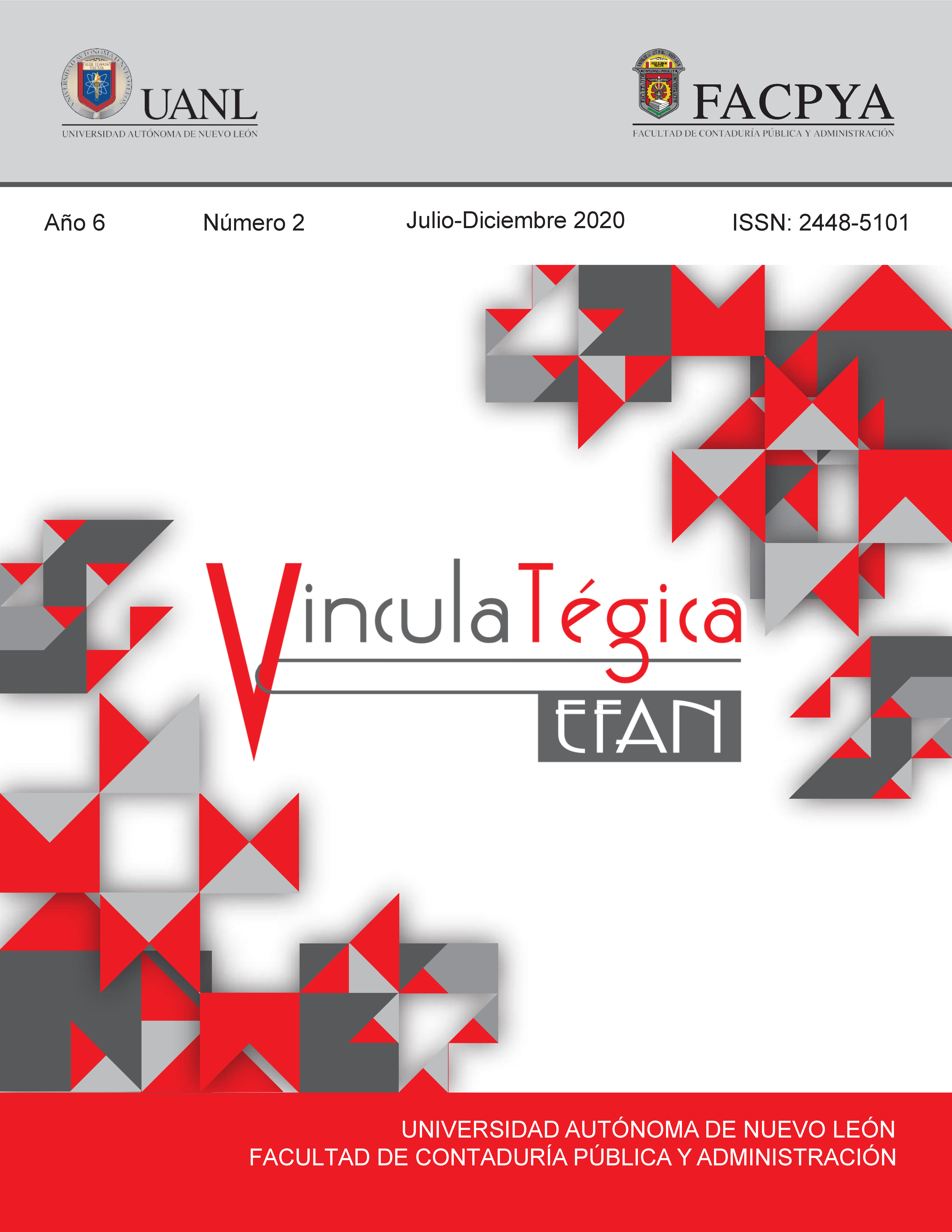Comparative analysis of productivity factors between Japan and Mexico to promote the Mexican Automotive Industry
DOI:
https://doi.org/10.29105/vtga6.2-566Keywords:
Productividad, automotriz, factoresAbstract
Currently, there are 10 leading countries in the automotive industry worldwide, which produce 75.2 million motor vehicles, this represents 78.68% of the total. The countries that are in the first 5 countries that lead the top of the largest automotive producers worldwide are China, the United States, Japan, India and Germany. The automotive industry manufactures 95.6 million motor vehicles. Mexico's production has increased by 152% from 1999 to 2018. In the last 11 years, Mexico has been part of the elite group of the first 10 automotive producing countries worldwide and although it has advanced positions in the table of world producers, it has achieved reach number 6, but has not managed to place itself among the first 5. This research will be aimed at making a comparison between relevant productivity factors in Japan and Mexico.Downloads
References
Adrian, J. J. (1987). Construction productivity improvement. New York et Al.: Elsevier.
Allmon, E., Haas, C. T., & Borcherding, J. D. Goodrum, P. M. (2000). US construction labor productivity trends, 1970–1998. Journal of Construction Engineering and Management, 126(2), 97–104. DOI: https://doi.org/10.1061/(ASCE)0733-9364(2000)126:2(97)
Alvarez, R., Bravo-Ortega, C., & Zahler, A. (2015). Innovation and Productivity in Services: Evidence from Chile. Emerging Markets Finance and Trade, 51(3), 593–611. DOI: https://doi.org/10.1080/1540496X.2015.1026696
Andersson, U., Dasí, Á., Mudambi, R., & Pedersen, T. (2016). Technology, innovation and knowledge: The importance of ideas and international connectivity. Journal of World Business, 51(1), 153–162. DOI: https://doi.org/10.1016/j.jwb.2015.08.017
Arditi, D., & Mochtar, K. ". (2000). Trends in productivity improvement in the US construction industry. Construction Management & Economics, 18(1), 15–27. DOI: https://doi.org/10.1080/014461900370915
Baines, D., Bates, I., Bader, L., Hale, C., & Schneider, P. (2018). Conceptualising production, productivity and technology in pharmacy practice: a novel framework for policy, education and research. Human Resources for Health, 16(1), 51. DOI: https://doi.org/10.1186/s12960-018-0317-5
Bender, S., Bloom, N., Card, D., Van Reenen, J., & Wolter, S. (2018). Management Practices, Workforce Selection, and Productivity. Journal of Labor Economics, 36(S1), S371–S409. DOI: https://doi.org/10.1086/694107
Birdi, K., Clegg, C., Patterson, M., Robinson, A., Stride, C. B., Wall, T. D., & Wood, S. J. (2008). The impact of human resource and operational management practices on company productivity: A longitudinal study. Personnel Psychology, 61(3), 467–501. https://doi.org/10.1111/j.1744-6570.2008.00136.x DOI: https://doi.org/10.1111/j.1744-6570.2008.00136.x
Bontis, N. (1998). Intellectual capital: an exploratory study that develops measures and models. Management Decision, 36(2), 63–76. DOI: https://doi.org/10.1108/00251749810204142
Chadwick, C., Way, S. A., Kerr, G., & Thacker, J. W. (2013). Boundary Conditions of the HighInvestment Human Resource Systems-Small-Firm Labor Productivity Relationship. Personnel Psychology, 66(2), 311–343. https://doi.org/10.1111/peps.12015 DOI: https://doi.org/10.1111/peps.12015
Chandra, C., Everson, M., & Grabis, J. (2005). Evaluation of enterprise-level benefits of manufacturing flexibility. Omega, 33(1), 17–31. DOI: https://doi.org/10.1016/j.omega.2004.03.004
Crowley, F., & Mccann, P. (2014). Innovation and Productivity in Irish Firms. Spatial Economic Analysis. DOI: https://doi.org/10.1080/17421772.2015.1023340
Datta, D. K., Guthrie, J. P., & Wright, P. M. (2005). Human resource management and labor productivity: Does industry matter? Academy of Management Journal, 48(1), 135–145. https://doi.org/10.5465/AMJ.2005.15993158 DOI: https://doi.org/10.5465/amj.2005.15993158
Dengiz, B., Iç, Y. T., & Belgin, O. (2015). A meta-model based simulation optimization using hybrid simulation-analytical modeling to increase the productivity in automotive industry. Mathematics and Computers in Simulation, 120, 120–128. https://doi.org/10.1016/j.matcom.2015.07.005 DOI: https://doi.org/10.1016/j.matcom.2015.07.005
El-Gohary, K. M., & Aziz, R. F. (2013). Factors influencing construction labor productivity in Egypt. Journal of Management in Engineering, 30(1), 1–9. DOI: https://doi.org/10.1061/(ASCE)ME.1943-5479.0000168
Finke, M. R. (1998). A better way to estimate and mitigate disruption. Journal of Construction Engineering and Management, 124(6), 490–497. DOI: https://doi.org/10.1061/(ASCE)0733-9364(1998)124:6(490)
Fu, X., Mohnen, P., & Zanello, G. (2018). Innovation and productivity in formal and informal firms in Ghana. Technological Forecasting and Social Change, 131, 315–325. DOI: https://doi.org/10.1016/j.techfore.2017.08.009
Fuentes, A., & Pipkin, S. (2019). Neither synthesis nor rivalry: Complementary policy models and technological learning in the Mexican and Brazilian petroleum and automotive industries. Business and Politics, 21(1), 113–144. DOI: https://doi.org/10.1017/bap.2018.23
Gamal, M., & Mohamed, S. (2012). Factors influencing perceived productivity of Egyptian teleworkers: An empirical study. Measuring Business Excellence, 16(2), 3–22. https://doi.org/10.1108/13683041211230285 DOI: https://doi.org/10.1108/13683041211230285
Ganesan, S. (1984). Construction productivity. Habitat International, 8(3–4), 29–42. DOI: https://doi.org/10.1016/0197-3975(84)90041-9
Hallgren, M., & Olhager, J. (2009). Flexibility configurations: Empirical analysis of volume and 1280 product mix flexibility. Omega, 37(4), 746–756. DOI: https://doi.org/10.1016/j.omega.2008.07.004
Handa, V. K., & Abdalla, O. (1989). Forecasting productivity by work sampling. Construction Management and Economics, 7(1), 19–28. DOI: https://doi.org/10.1080/01446198900000003
Horner, M., & Duff, R. (2001). A Contractor‟ s Guide To Improving Productivity in Construction. CIRIA, London.
Ishida, S; Magnusson, M & Nagahira, A (2017). Factors influencing Japanese auto suppliers’ predictions about the future of new technologies – An exploratory study of electric vehicles. Futures, 89, 38-59. DOI: https://doi.org/10.1016/j.futures.2017.03.009
Jha, S., & Bag, D. (2019). The service sector: migration, technology and productivity. International Journal of Sociology and Social Policy, 39(1/2), 2–21. DOI: https://doi.org/10.1108/IJSSP-10-2017-0141
Katou, A. A., & Budhwar, P. (2015). Human resource management and organisational productivity: A systems approach based empirical analysis. Journal of Organizational Effectiveness, 2(3), 244–266. https://doi.org/10.1108/JOEPP-06-2015-0021 DOI: https://doi.org/10.1108/JOEPP-06-2015-0021
Koch, M., & Mcgrath, R. G. (1996). I- RESOURCE MANAGEMENT POLICIES DO MAlTER. Management, 17(January 1994), 335–354. DOI: https://doi.org/10.1002/(SICI)1097-0266(199605)17:5<335::AID-SMJ814>3.0.CO;2-R
Kogan, L., Papanikolaou, D., Seru, A., & Stoffman, N. (2017). Technological innovation, resource allocation, and growth. Quarterly Journal of Economics, 132(2), 665–712. DOI: https://doi.org/10.1093/qje/qjw040
Krasova, E. (2018). Characteristics of global automotive industry as a sector with high levels of production internationalization. Amazonia Investiga, 7(16), 84–93.
Läpple, D., Renwick, A., & Thorne, F. (2015). Measuring and understanding the drivers of agricultural innovation: Evidence from Ireland. Food Policy, 51, 1–8. DOI: https://doi.org/10.1016/j.foodpol.2014.11.003
Lee, C., & Leem, C. (2016). An empirical analysis of issues and trends in manufacturing productivity through a 30-year literature review. South African Journal of Industrial Engineering, 27(2), 147–159. DOI: https://doi.org/10.7166/27-2-1363
Mitra, S. (2019). Depletion, technology, and productivity growth in the metallic minerals industry. Mineral Economics, 32(1), 19–37. https://doi.org/10.1007/s13563-018-0165-8 DOI: https://doi.org/10.1007/s13563-018-0165-8
Morris, D. M. (2018). Innovation and productivity among heterogeneous firms. Research Policy, 47(10), 1918–1932. DOI: https://doi.org/10.1016/j.respol.2018.07.003
OICA. (2018). International Organization of Motor Vehicle Manufacturers.
OICA. (2019). International Organization of Motor Vehicle Manufacturers.
Peles, C. J. (1987). Productivity analysis–a case study. Transaction of the American Association of Cost Engineers, 31st Annual Meeting, Atlanta.
Phusavat, K., Jaiwong, P., Sujitwanich, S., & Kanchana, R. (2009). Industrial Management & Data Systems Article information :
Quigley, J., Walls, L., Demirel, G., MacCarthy, B. L., & Parsa, M. (2018). Supplier quality improvement: The value of information under uncertainty. European Journal of Operational Research, 264(3), 932–947. DOI: https://doi.org/10.1016/j.ejor.2017.05.044
Quintero, C., & Marinaro, P. (2019). The remaking of the Mexican labor movement in the automotive industry. Journal of Labor and Society, 22(1). DOI: https://doi.org/10.1111/wusa.12413
Quintero, R. (2015). Cinco Décadas de Empleo Maquilador: De Fuente Laboral Femenína a Empleo Regional. Congreso Medio Siglo de Maquiladora:¿ Qué Nos Ha Dejado, Hacia Donde Vamos.".
Ruiz, C. (2015). Internal and external sources of capacity building in the Mexican auto-parts industry. A University of Sussex.
Sánchez, A. M., Pérez, M. P., De Luis Carnicer, P., & Jiménez, M. J. V. (2007). Teleworking and workplace flexibility: A study of impact on firm performance. Personnel Review, 36(1), 4264. https://doi.org/10.1108/00483480710716713 DOI: https://doi.org/10.1108/00483480710716713
Topp, V., Soames, L., Parham, D., & Bloch, H. (2008). Productivity in the Mining Industry: Measurement and Interpretation.
Uluskan, M., Joines, J. A., & Godfrey, A. B. (2016). Comprehensive insight into supplier quality and the impact of quality strategies of suppliers on outsourcing decisions. Supply Chain 1281 Management: An International Journal, 21(1), 92–102. DOI: https://doi.org/10.1108/SCM-04-2015-0140
Wang, Wen, & Heyes, J. (2017). Flexibility, labour retention and productivity in the EU. International Journal of Human Resource Management, 5192(January), 1–21. https://doi.org/10.1080/09585192.2016.1277370 DOI: https://doi.org/10.1080/09585192.2016.1277370
Yaduma, N., Lockwood, A. J., & Williams, A. (2013). Demand Fluctuations, Labour Flexibility and Productivity. Journal of Chemical Information and Modeling, 53(9), 1689–1699. https://doi.org/10.1017/CBO9781107415324.004 DOI: https://doi.org/10.1017/CBO9781107415324.004
Yamamura, E., & Shin, I. (2007). Technological change and catch-up and capital deepening: Relative contributions to growth and convergence: Comment. Economics Bulletin, 15(3).
Yu, O. (2018). Innovation and Its Importance and Recent Popularity. IEEE Engineering Management Review, 46(1), 27–28 DOI: https://doi.org/10.1109/EMR.2018.2809920
Downloads
Published
How to Cite
Issue
Section
License
Copyright (c) 2023 Loraine Gastell-Piloto, Jesús Gerardo Cruz-Álvarez

This work is licensed under a Creative Commons Attribution 4.0 International License.
a). Authors keep copyright and give the journal the right of the first publication of the work under a Creative Commons attribution license. This license allows others to share the work as long as original authorship and initial publication in this journal is acknowledged.
b). Authors may make other independent and additional contractual agreements for the non-exclusive distribution of the version of the article published in this journal (e.g., include it in an institutional repository or publish it in a book) as long as they clearly indicate that the work was published for the first time in this journal.







